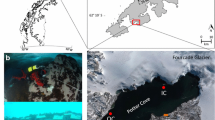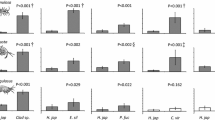Abstract
The fauna inhabiting the brown seaweed Sargassum muticum (Yendo) Fensholt was studied at Friday Harbor, Washington, USA over a 2 mo period (July/August, 1978). The fauna lacked diversity, but a few species were found frequently and in great abundance, namely the amphipods Ampithoë mea Gurjanova, Aoroides columbiae Walker, Caprella laeviuscula Mayer and Ischyrocerus anguipes Kryer, and the gastropod Lacuna variegata Carpenter. All of these vagile species were more abundant on the better illuminated distal regions of the plant, where there was an abundant coating of the diatoms Biddulphia aurita (Lyngb.) de Breb and Melosira dubia (C. A. Ag.) Kutz. A comparison between plants bearing different periphyton loads revealed that Aoroides columbiae and C. laeviuscula were far more abundant on heavily infested plants. A similar trend was evident for Ampthoë mea and L. variegata, but was not sufficiently marked to be statistically significant. Plants bearing silt rather than diatoms supported reduced numbers of all the common species of associated animals and especially C. laeviuscula. The results of substratum selection experiments in the laboratory corresponded to the expectations raised by the field observations. Both A. mea and C. laeviuscula were strongly attracted to S. muticum, especially if it was coated with diatoms. Only live diatoms were attractive. C. laeviuscula shunned dead diatoms and also a thin layer of silt. L. variegata proved indifferent to S. muticum, diatoms or silt. The preferences exhibited are discussed in relation to the diet of each species as well as its need for a secure perch in a turbulent environment, and concealment from predators. The grazing rates of each of the three commonest herbivores found on S. muticum were also assessed. Ampithoë mea consumed up to 4.4 mg of S. muticum tissue per individual per day, although nest-building activities greatly added to its depredations. C. laeviuscula fed largely on diatoms and did not harm S. muticum. L. variegata was the most significant of the grazers tested. Full grown specimens consumed 8.1 mg tissue individual-1 d-1, but small specimens consumed more in relation to their body weight, 1.55 mg tissue per mg animal soft tissue-1 d-1. Estimates based on the abundance of grazers on S. muticum, their feeding rates and the growth rates of the plants revealed that in late summer, epiphytic grazers could remove more tissue than is being formed. This was, however, the slow growth period for S. muticum, and earlier in the year its very rapid growth should more than compensate for the effects of epiphytic grazers. In autumn, much of the fauna of S. muticum was lost with the natural defoliation of the plants, which therefore, must be restocked annually, probably from animals inhabiting nearby Zostera marina beds.
Similar content being viewed by others
Literature cited
Boaden, P. J. S., R. J. O. O'Connor and R. Seed: The composition and zonation of a Fucus serratus community in Co. Down. J. exp. mar. Biol. Ecol. 17, 111–136 (1975)
Brawley, S. H. and W. H. Adey: Micrograzers may affect macroalgal density. Nature, Lond. 292. p. 177 (1981)
Caine, E. A.: Feeding mechanisms and possible resource partitioning of the Caprellidae (Crustacea: Amphipoda) from Puget Sound, USA. Mar. Biol. 42, 331–336 (1977)
Caine, E. A.: Population structures of two species of caprellid amphipods. J. exp. mar. Biol. Ecol. 40, 103–114 (1979)
Caine, E. A.: Ecology of two littoral species of caprellid amphipods (Crustacea) from Washington, USA. Mar. Biol. 56, 327–335 (1980)
Colman, J. S.: On the faunas inhabiting intertidal seaweeds. J. mar. biol. Ass. UK. 24, 129–183 (1940)
Dahl, E.: On the smaller Arthropoda of marine algae, especially in the polyhaline waters of the Swedish West Coast. Unders. Öresund (Lund) 35, 1–193 (1948). (Dissertation, Lund University)
Deysher, L. and T. A. Norton: Dispersal and colonization in Sargassum muticum (Yendo) Fensholt. J. exp. mar. Biol. Ecol. 56, 179–195 (1982)
Fralick, R. A., K. W. Turgeon and A. C. Mathieson: Destruction of kelp populations by Lacuna vincta (Montagu). Nautilus 88 112–114 (1974)
Fretter, V. and R. Manly: Algal associations of Tricolia pullus, Lacuna vincta and Cerithiopsis tubercularis (Gastropoda) with special reference to the settlement of their larvae. J. mar. biol. Ass. UK. 57, 999–1017 (1977)
Gray, P. W. G.: An investigation of the fauna associated with Sargassum muticum, 272 pp. Ph. D. thesis, CNAA Portsmouth Polytechnic 1978
Gunnill, F. C.: Macroalgae as habitat patch islands for Scutellidium lamellipes (Copepoda: Harpacticoidea) and Ampithoe tea (Amphipoda: Gammaridae). Mar. Biol. 69, 103–116 (1982)
Hagerman, L.: The macro and microfauna associated with Fucus serratus L. with some ecological remarks. Ophelia 3, 1–43 (1966)
Hicks, G. R. F.: Structure of phytal harpacticoid copepod assemblages and the influence of habitat complexity and turbidity. J. exp. mar. Biol. Ecol. 44, 157–192 (1980)
Kozloff, E. N.: Keys to the marine invertebrates of Puget Sound, the San Juan archipelago and adjacent regions, 226 pp. Seattle: University of Washington 1974
Martinez-Nadal, N. G., L. V. Rodriguez and C. Casillas: Isolation and characterisation of sarganim complex, a new broad spectrum antibiotic isolated from marine algae. Antimicrob. Ag. Chemother. 1964, 131–134 (1965)
Moore, P. G.: Particulate matter in the sublittoral zone of an exposed coast and its ecological significance, with special reference to the fauna inhabiting kelp holdfasts. J. exp. mar. Biol. Ecol. 10, 59–80 (1972)
Mukai, H.: The phytal animals on the thalli of Sargassum serratifolium in the Sargassum region, with reference to their seasonal fluctuations. Mar. Biol. 8, 170–182 (1971)
Nicholson, N. H. Hosmer, K. Bird, L. Hart, W. Sandlin C. Shoemaker and C. Sloan: The biology of Sargassum muticum (Yendo) Fensholt at Santa Catalina Island, California. Proc. int. Seaweed Symp. 8 (Bangor, 1974), 416–424 (1981). (Ed. by G. E. Fogg and W. E. Jones. Menai Bridge, N. Wales: The Marine Science Laboratory)
Norton, T. A.: An ecological study of the fauna inhabiting the sublittoral marine alga Saccorhiza polyschides. Hydrobiologia 37, 215–231 (1971)
Norton, T. A.: The growth and development of Sargassum muticum (Yendo) Fensholt. J. exp. mar. Biol. Ecol. 26, 41–53 (1977)
Ohm, G.: Die Besiedlung der Fucus-zone der Kieler Bucht und der westlichen Ostsee unter besonderer Berücksichtigung der Kikrofauna. Kieler Meeresforsch. 20, 30–64 (1964)
Round, F. E., J. F. Sloane, F. J. Ebling and J. A. Kitching: The ecology of Lough Ine. X. The hydroid Sertularia operculata (L.) and its associated flora and fauna: effects of transference to sheltered water. J. Ecol. 49, 617–629 (1961)
Ryland, J. S.: Observations on some epibionts of gulf weed, Sargassum natans (L.) Meyer. J. exp. mar. Biol. Ecol. 14, 17–27 (1974)
Sieburth, J. McN. and J. T. Conover: Sargassum tannin, an antibiotic which retards fouling. Nature, Lond. 208, 52–53 (1965)
Staude, C. P., J. W. Armstrong, R. M. Thom and K. K. Chew: An illustrated key to the intertidal gammaridean Amphipoda of Central Puget Sound. Contr. Univ. Wash. College Fish. 466, 1–27 (1977)
Stoner, A. W.: Perception and choice of substratum by epifaunal amphipods associated with seagrasses. Mar. Ecol. Prog. Ser. 3, 105–111 (1980)
Withers, R. G., W. F. Farnham, S. Lewey, N. A. Jephson, J. M. Haythorn and P. W. G. Gray: The epibionts of Sargassum muticum in British waters. Mar. Biol. 31, 79–86 (1975)
Zimmerman, R., R. Gibson and J. Harrington: Herbivory and detritivory among gammaridean amphipods from a Florida seagrass community. Mar. Biol. 54, 41–47 (1979)
Author information
Authors and Affiliations
Additional information
Communicated by J. Mauchline, Oban
Rights and permissions
About this article
Cite this article
Norton, T.A., Benson, M.R. Ecological interactions between the brown seaweed Sargassum muticum and its associated fauna. Mar. Biol. 75, 169–177 (1983). https://doi.org/10.1007/BF00405999
Accepted:
Issue Date:
DOI: https://doi.org/10.1007/BF00405999




